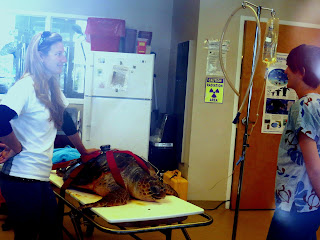 |
| Deserted beach in Delray Beach, Florida, with stakes where turtles have nested |
On our three-mile stretch of beach, thousands of female sea turtles return at night to lay their eggs between March 1st and October 31st. In 2017, there were 1077 nests, the highest number ever recorded in our area. It is estimated nearly ninety percent of all sea turtle nesting in the U.S. occurs right here (www.sunny.org/beaches/sea-turtles). This year the turtle stakes have already begun to appear, and experts expect a bumper crop.
We have four species that return to our area: loggerhead, leatherback, green, and hawksbill. Since artificial lighting discourages the females from nesting on the beach, there is an ordinance in Florida (and fine for offenses) that all outside lights must be turned off or inward during nesting season.
The females' tracks are as big as a tractor's tire marks. They dig holes in the sand, lay around one hundred golf-ball size eggs, cover the hole with sand, and spread sand over a large area to disguise the hole. Then they re-enter the water. Although I have seen the track marks in the sand, I have never witnessed the nocturnal nesting.
Incubation will last 45-55 days. The hatchlings use reflections from the moon to find their way down to the water at night. Only one out of a thousand will survive the predators and the tides.
 |
| Wheelchair for sick turtles, Juno Beach Turtle Rehab Center, Florida |
 |
| Sick turtle getting an IV, Juno Beach Turtle Rehab Center, Fl. |
In our area of beach, a non-profit organization called Sea Turtle Adventures provides daily monitoring of the nests on a three-mile stretch. They stake, relocate nests as needed, and excavate them after hatching. The group also provides documentation and reporting of predation events, offensive artificial lighting during nesting season, and obstructed nesting attempts. It co-ordinates efforts to document and transport dead or injured sea turtles to a rehab facility (such as the Juno Beach Center), and provides annual reports to the Florida Fish and Wildlife Conservation Commission.
The mounds and orange stakes couldn't be more welcome this year!
 |
| May, 2018 |
